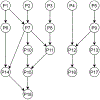Graph Theoretic Approach for the Analysis of Comprehensive Mass-Spectrometry (MS/MS) Data of Dissolved Organic Matter
- PMID: 35425661
- PMCID: PMC9007174
- DOI: 10.1109/bibm52615.2021.9669289
Graph Theoretic Approach for the Analysis of Comprehensive Mass-Spectrometry (MS/MS) Data of Dissolved Organic Matter
Abstract
Dissolved organic matter (DOM) is a highly complex mixture of organic substances found in aquatic ecosystems. This mixture results from the degradation of primary producers within the ecosystem, groundwater, and the surrounding terrestrial sources. Understanding the chemical structure of DOM is crucial to assessing its impact on aquatic ecosystems. Although multiple studies have addressed the complexity of DOM, the molecular structure of this set of compounds remains unclear. In this work, we present a novel computational framework "Graph-DOM," to assess the comprehensive fragmentation data obtained from the analysis of DOM using the Data Independent Fragmentation strategy with ESI-FT-ICR MS/MS enabling better understanding of the structural complexity of DOM. Graph-DOM uses graph algorithms to dissect a compiled output file obtained from processing hundreds of ultra-high-resolution fragment spectra. Over half a million ordered fragmentation pathways were computed for 764 isolated precursor ions assuming up to seven vector segments categorized as neutral losses (CH2, CH3, O, CH4, H2O, CO, and CO2). Families of structurally related molecules were identified using pathway overlaps, and output files compatible with network visualization software (e.g., Cytoscape) were also generated. Graph-DOM is able to efficiently process all the pathways to discover families within only a few minutes with adjustable parameters for overlap length of fragmentation pathways as well as configuring low abundance CHOS, CHON, and CHONS compounds. Graph-DOM is available at https://github.com/Usman095/Graph-DOM.
Keywords: HPC; dissolved organic matter; dynamic programming; regularity chains.
Figures









References
-
- Kaplan L and Cory R, “Dissolved organic matter in stream ecosystems: forms, functions, and fluxes of watershed tea,” in Stream ecosystems in a changing environment. Elsevier, 2016, pp. 241–320.
-
- Hertkorn N, Harir M, Koch BP, Michalke B, and Schmitt-Kopplin P, “High-field nmr spectroscopy and fticr mass spectrometry: powerful discovery tools for the molecular level characterization of marine dissolved organic matter,” Biogeosciences, vol. 10, no. 3, pp. 1583–1624, 2013.
-
- Zark M, Christoffers J, and Dittmar T, “Molecular properties of deep-sea dissolved organic matter are predictable by the central limit theorem: Evidence from tandem ft-icr-ms,” Marine Chemistry, vol. 191, pp. 9–15, 2017.
-
- Hertkorn N, Harir M, Cawley KM, Schmitt-Kopplin P, and Jaffé R, “Molecular characterization of dissolved organic matter from subtropical wetlands: a comparative study through the analysis of optical properties, nmr and fticr/ms,” Biogeosciences, vol. 13, no. 8, pp. 2257–2277, 2016.
-
- Green NW, Perdue EM, Aiken GR, Butler KD, Chen H, Dittmar T, Niggemann J, and Stubbins A, “An intercomparison of three methods for the large-scale isolation of oceanic dissolved organic matter,” Marine Chemistry, vol. 161, pp. 14–19, 2014.
Grants and funding
LinkOut - more resources
Full Text Sources
